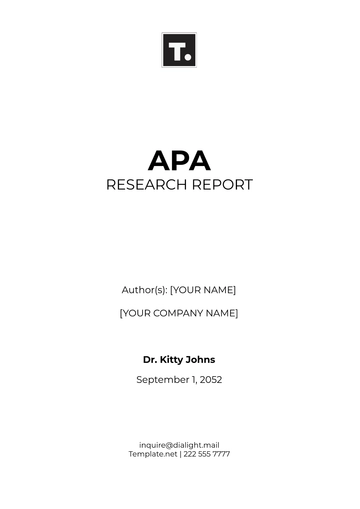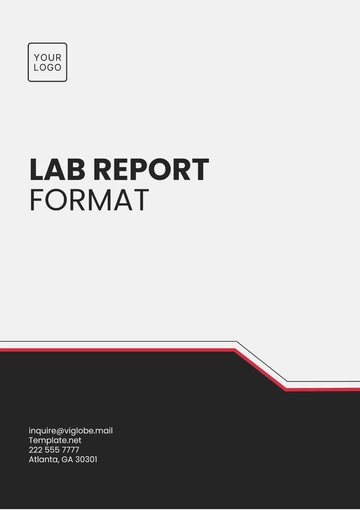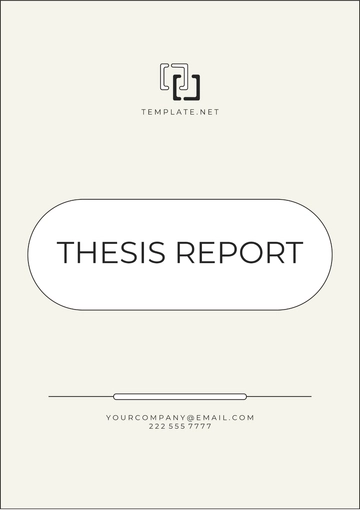Free Academic Research Project Report

Prepared By | University | Date Prepared |
|---|---|---|
[Your Name] | [Your Company Name] | [CURRENT DATE] |
I. Abstract
This research delves into how interactive learning platforms impact higher education. By combining quantitative surveys and qualitative interviews, the study explores the effectiveness of interactive features in digital learning. Initial findings show a positive correlation between interactive elements and enhanced student engagement, thereby underscoring the significance of interactive platforms in modern education.
II. Introduction
2.1 Background and Context
The rapid evolution of digital technology has significantly influenced the educational landscape, leading to the widespread adoption of online learning in educational institutions. Despite this transition, effectively harnessing technology's full potential in digital education requires a nuanced approach. Traditional classroom settings differ from digital formats in various aspects, necessitating tailored strategies to optimize learning experiences.
2.2 Research Objectives and Questions
The primary objective of this research is to critically evaluate how interactive features within online learning platforms influence student engagement, participation, and academic performance. Key questions guiding this investigation include:
Assessing the effectiveness of various interactive elements.
Understanding student preferences and perceptions regarding interactivity.
Identifying best practices for integrating interactive features into digital courses.
III. Theoretical Framework
3.1 Conceptual Framework
To provide a robust foundation for this study, we employ a conceptual framework grounded in theories of engagement, motivation, and interactive learning models. Key concepts include:
Cognitive Engagement: Focuses on mental processes like critical thinking and problem-solving during learning activities. Interactive platforms stimulate cognitive engagement through simulations, multimedia, and adaptive learning tools.
Social Interaction: Facilitates collaborative learning and knowledge sharing. Interactive platforms use features like discussion forums and group projects to foster a sense of community among learners.
Gamification: Integrates game elements to motivate and engage students. Strategies like badges and leaderboards promote participation and progress in learning tasks.
Personalized Learning: Tailors learning experiences to individual needs and preferences. Platforms use data-driven approaches to provide adaptive content, feedback, and challenges for enhanced learning outcomes.
IV. Literature Review
4.1 Review of Existing Literature
A comprehensive review of existing literature is undertaken to contextualize the research within the broader scholarly discourse. This review synthesizes empirical studies, theoretical perspectives, and practical insights related to:
Interactive Learning Platforms: Examines how features like multimedia, gamification, and personalized learning impact student engagement and outcomes.
Student Engagement: Explores factors influencing engagement in online learning, including instructional design and technology use.
Digital Pedagogy: Analyzes pedagogical strategies and theories applied in digital education, focusing on active learning and collaboration.
V. Methodology
5.1 Research Design
This study employs a mixed-methods research design to capture a holistic view of the research phenomenon. The methodology includes:
Quantitative data collection through online surveys distributed among students.
Qualitative data gathering via semi-structured interviews with educators and administrators.
5.2 Sampling Strategy
A purposive sampling strategy ensures representation across diverse student demographics, academic disciplines, and institutional settings.
Ethical considerations include obtaining informed consent and protecting participant confidentiality.
5.3 Data Collection and Analysis
Quantitative data collection focuses on assessing various aspects of student engagement, satisfaction with interactive features, perceived learning outcomes, and preferences for different types of interactivity.
Qualitative data collection involves an in-depth exploration of educators' and administrators' experiences with interactive platforms.
VI. Results and Findings
6.1 Presentation of Quantitative Findings
Quantitative findings are presented using descriptive statistics, frequency distributions, and graphical representations to elucidate patterns and trends in student engagement and perceptions of interactive features.
6.2 Qualitative Insights
Qualitative findings are presented through thematic analysis, where recurring themes, patterns, and narratives are identified from interview transcripts. Direct quotes and rich descriptions add depth to qualitative data.
VII. Discussion and Interpretation
7.1 Interpretation of Results
Insights into the impact of interactive platforms on student engagement, motivation, and learning outcomes are provided, drawing connections to the theoretical framework and existing literature.
7.2 Comparison with Literature
Comparative analysis validates findings and contributes to theoretical advancements, discussing consistencies, discrepancies, and emergent themes.
VIII. Conclusion and Implications
8.1 Summary of Findings
Key insights regarding interactive platforms' effectiveness are summarized, emphasizing their impact on student engagement, participation, and learning experiences.
8.2 Educational Implications
Recommendations are provided for optimizing interactive features, designing learner-centered activities, fostering collaborative learning environments, and promoting digital literacy skills among students.
Educational implications extend to curriculum design, pedagogical strategies, and ongoing professional development initiatives.
8.3 Limitations and Caveats
The study acknowledges its limitations, including potential biases in self-reported data, constraints related to sample size and generalizability, and the dynamic nature of technology-mediated learning environments.
IX. Recommendations for Practice
9.1 Pedagogical Strategies
Evidence-based recommendations are proposed for educators to effectively integrate interactive elements into online courses, including strategies like:
Gamification: Incorporating game-like features such as badges and leaderboards to boost student motivation and engagement.
Multimedia Resources: Using diverse multimedia content like videos and infographics to cater to different learning styles and enhance content retention.
Collaborative Tools: Implementing platforms for group projects and discussions to encourage peer interaction and collaborative learning.
Adaptive Learning Technologies: Utilizing adaptive platforms to personalize learning based on individual student needs and progress.
9.2 Technology Integration
Recommendations focus on optimizing technology infrastructure and learning management systems to support interactive learning experiences, emphasizing usability, accessibility, interoperability, and continuous improvement of digital platforms.
9.3 Professional Development
Suggestions are offered for professional development initiatives aimed at enhancing educators' digital literacy, instructional design competencies, pedagogical strategies for online teaching, and innovative approaches to leveraging interactive technologies.
X. Future Research Directions
10.1 Research Opportunities
Areas for further investigation include longitudinal studies on sustained engagement, comparative analyses of different interactive features, cross-cultural perspectives on interactive learning, and innovative pedagogical models integrating emerging technologies.
10.2 Longitudinal Studies
Recommendations are made for longitudinal studies or follow-up research to assess the long-term impact of interactive platforms on student learning trajectories, academic success, retention rates, and overall satisfaction with online education.
XI. References
Anderson, T., & Dron, J. (2011). Three generations of distance education pedagogy. The International Review of Research in Open and Distributed Learning, 12(3), 80-97.
Bates, A. W. (2015). Teaching in a digital age: Guidelines for designing teaching and learning. Tony Bates Associates Ltd.
Dede, C. (2010). Comparing frameworks for 21st-century skills. 21st Century Skills: Rethinking How Students Learn, 51, 51-76.
Garrison, D. R., & Anderson, T. (2003). E-learning in the 21st century: A framework for research and practice. Routledge.
Siemens, G., & Tittenberger, P. (2009). Handbook of emerging technologies for learning. University of Manitoba Press.
XII. Appendices
Appendix A: Survey Instrument - Student Engagement and Satisfaction Survey
Appendix B: Interview Protocol - Educators' Experiences with Interactive Platforms
Appendix C: Raw Data Excerpts - Quantitative Analysis Results
Appendix D: Coding Scheme for Qualitative Analysis
Appendix E: Additional Analyses - Comparative Analysis of Interactive Features
Appendix F: Participant Consent Forms
Appendix G: Institutional Review Board Approval Letter
- 100% Customizable, free editor
- Access 1 Million+ Templates, photo’s & graphics
- Download or share as a template
- Click and replace photos, graphics, text, backgrounds
- Resize, crop, AI write & more
- Access advanced editor
Present your research findings effectively with Template.net's Academic Research Project Report Template. This editable and customizable tool helps you organize your research objectives, methodology, results, and conclusions. Create detailed and professional reports for academic evaluation. Editable in our AI Editor Tool, this template ensures precise and thorough academic research reporting, facilitating clear and impactful communication of your research work.
You may also like
- Sales Report
- Daily Report
- Project Report
- Business Report
- Weekly Report
- Incident Report
- Annual Report
- Report Layout
- Report Design
- Progress Report
- Marketing Report
- Company Report
- Monthly Report
- Audit Report
- Status Report
- School Report
- Reports Hr
- Management Report
- Project Status Report
- Handover Report
- Health And Safety Report
- Restaurant Report
- Construction Report
- Research Report
- Evaluation Report
- Investigation Report
- Employee Report
- Advertising Report
- Weekly Status Report
- Project Management Report
- Finance Report
- Service Report
- Technical Report
- Meeting Report
- Quarterly Report
- Inspection Report
- Medical Report
- Test Report
- Summary Report
- Inventory Report
- Valuation Report
- Operations Report
- Payroll Report
- Training Report
- Job Report
- Case Report
- Performance Report
- Board Report
- Internal Audit Report
- Student Report
- Monthly Management Report
- Small Business Report
- Accident Report
- Call Center Report
- Activity Report
- IT and Software Report
- Internship Report
- Visit Report
- Product Report
- Book Report
- Property Report
- Recruitment Report
- University Report
- Event Report
- SEO Report
- Conference Report
- Narrative Report
- Nursing Home Report
- Preschool Report
- Call Report
- Customer Report
- Employee Incident Report
- Accomplishment Report
- Social Media Report
- Work From Home Report
- Security Report
- Damage Report
- Quality Report
- Internal Report
- Nurse Report
- Real Estate Report
- Hotel Report
- Equipment Report
- Credit Report
- Field Report
- Non Profit Report
- Maintenance Report
- News Report
- Survey Report
- Executive Report
- Law Firm Report
- Advertising Agency Report
- Interior Design Report
- Travel Agency Report
- Stock Report
- Salon Report
- Bug Report
- Workplace Report
- Action Report
- Investor Report
- Cleaning Services Report
- Consulting Report
- Freelancer Report
- Site Visit Report
- Trip Report
- Classroom Observation Report
- Vehicle Report
- Final Report
- Software Report





























